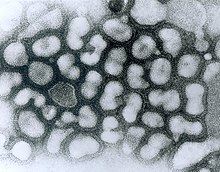Influenzavirus A
| Influenza A virus | |
|---|---|
 |
|
| Electron micrograph of influenza A viruses | |
| Virus classification | |
| Group: | Group V ((-)ssRNA) |
| Order: | Unassigned |
| Family: | Orthomyxoviridae |
| Genus: | Influenzavirus A |
| Species: | Influenza A virus |
Influenza A virus causes influenza in birds and some mammals, and is the only species of influenza virus A. Influenza virus A is a genus of the Orthomyxoviridae family of viruses. Strains of all subtypes of influenza A virus have been isolated from wild birds, although disease is uncommon. Some isolates of influenza A virus cause severe disease both in domestic poultry and, rarely, in humans. Occasionally, viruses are transmitted from wild aquatic birds to domestic poultry, and this may cause an outbreak or give rise to human influenza pandemics.
Influenza A viruses are negative-sense, single-stranded, segmented RNA viruses. The several subtypes are labeled according to an H number (for the type of hemagglutinin) and an N number (for the type of neuraminidase). There are 18 different known H antigens (H1 to H18) and 11 different known N antigens (N1 to N11). H17 was isolated from fruit bats in 2012. H18N11 was discovered in a Peruvian bat in 2013.
Each virus subtype has mutated into a variety of strains with differing pathogenic profiles; some are pathogenic to one species but not others, some are pathogenic to multiple species.
A filtered and purified influenza A vaccine for humans has been developed, and many countries have stockpiled it to allow a quick administration to the population in the event of an avian influenza pandemic. Avian influenza is sometimes called avian flu, and colloquially, bird flu. In 2011, researchers reported the discovery of an antibody effective against all types of the influenza A virus.
Influenza type A viruses are categorized into subtypes based on the type of two proteins on the surface of the viral envelope:
...
Wikipedia
